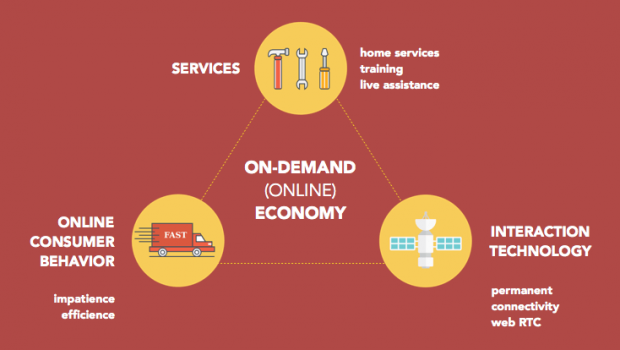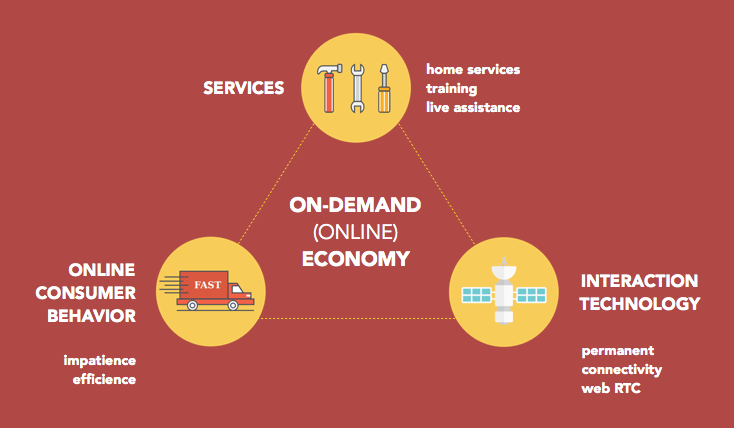On-demand Economy – Is it a Disturbance or Revolution?
In the recent times, there is much talk about the on-demand application as it is the economy that is defined as the economic activity created by technology companies, fulfilling its consumers’ demand through the instant provisioning of goods and services.
Across the world, providing 24*7 dedicated services have led to an economic revolution and with the touch on a smartphone screen, every single demand of users is fulfilling instantly than ever before.
What you will say about it – is it a disturbance or revolution in the industry?
Initially, the Internet, then eCommerce websites and then smartphones that instantly took over the traditional business strategies, but now, it is the on-demand economy.
Currently, the world is filled with enormous on-demand startups, which the promise of instant delivery of goods and services with just one tap on a mobile screen. However, there is no doubt that on-demand economy will transform the way people are transacting or using the services.
You can think Uber, think Airbnb and the services, which occupy through the business environment and how they are bringing an untold ease to the customer’s life with the help of smartphones.
The number of companies, categories and the growth of the industry is expanding constantly at a quickening pace. In this new economy, the business signifies the presence of years of technological innovation and an evolution in consumer behavior.
Moreover, it has also led to an always – connected and always-on the global economy, transforming the way we have been doing business before.
It is the arrival of a more convenient and faster business, where consumers are served on demand anytime and anywhere. In addition to this, supply and delivery are becoming more efficient and faster and layered on top of existing infrastructures.
But do you know that not every startup can adopt to on-demand ecosystem? Because it is not just about going online. There are other things that are more challenging – like to create a business model which is more scalable and gratifies the customer requirements in a more integrated manner.
Various consumers are not willing to download 50 apps to perform 50 different activities. Keeping this point in mind, the smart on-demand leaders have already developed a business model, which merge as various services as they can in a single application, delivering far more effective services.
Ultimately, the on-demand economy has laid more trustworthy and connecting consumer-supplier relationships as retailers are enabling consumers to completely personalize their purchasing experiences and rate the services later.
Considering On-demand Economy for Employees
With the on-demand economy, the completely different development has just begun within the organizations between employees and employers.
With this new economy, many new modes of working into offices have been introduced that again have rushed work flexibility for employees. With the introduction of Bring Your Own Device and Bring Your Own App and other enterprise mobility management models, they are feeling more content.
Various employers are allowing their employees to work from anywhere and anytime and on any device to fulfill the urgent requirements of clients and deliver work as per their availability.
The team members of the project are enjoying the freedom of performing their day-to-day tasks on their own devices that have developed more faith towards the organization as they comprehend that how strongly the company believes in them.
Creating Your Own Pathway
We all know that not all on-demand startups can follow the same model that we took. If you are one of those startup owners, who forget their road, below mentioned steps, can help you to find a pathway to profitability:
- Try to Evade Confirmation Bias
With the initial public offerings and exists, there is huge publicity, and most of it is powered by a dozen of successful exits every single year. However, you make sure that you don’t get intoxicated.
As per the CB Insights’ Q4 2015 report, the number of unicorn tech companies fell by 50% over the earlier quarter. Moreover, the least number of success stories doesn’t show a market-wide pattern. Therefore, focus on major targets and developing the product.
- Test Different Channels at Once
Do you know that Gabriel Weinberg and Justin Mares argue in TRACTION? They argued on startups that they should spend 50% of their time on the product with the other 50% being spent on testing and exploring growth channels like blogs, SEO, SEM, B2B/B2C sales and more.
You should test different channels at once so that you can determine that which respond considered as best in the current stage of development.
- Ensure That You Don’t Let Your Goals Decay
For measuring success and accomplishment, concrete targets are very important. No matter whether long-term and others, short-term, these must be updated daily. For example, you can set a user growth target of 10% month over month and can expand it to 12%. Every single change in target pushes the business near to success.
All the things considered, that on-demand economy is helping users, consumers, and other audience, allowing them faster communication, instant delivery and 24*7 services from their comfort of home. Along with it, it is also helpful for enterprises and companies to connect with their consumers efficiently and deliver them an excellent user experience.
___________________
If you are looking forward to developing an on-demand mobile application for your business, make sure you hire an experienced mobile app development company that has already developed on-demand apps for its clients.









![How Marketers Will Utilize iRobot Data [Infographic]](https://technofaq.org/wp-content/uploads/2017/08/Marketers-Use-Data-Analytics-IG-150x150.png)






